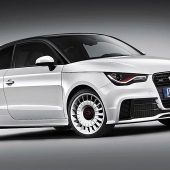At first glance, you wouldn’t guess that this SUV is diesel engined. Its sporty looks and the V6 T badges on the front fenders give you the idea of a powerful petrol engine. Well, this would be true if we we’re on the other side of the Atlantic Ocean, as in the US this car comes with the 3.0 TFSI petrol engine. However, here in Europe the Audi SQ5 is powered by a diesel engine. The Audi SQ5 is the first S model in the Q5 model series, and it is also the first S model with a diesel engine.
The Audi S models usually have a sportier exterior that differentiate them from the standard models. The Audi SQ5 makes no exception. First of all, the sport suspension lowers the car body by 30 millimetres. The huge 20-inch wheels with 255/45 tyres are standard feature. Behind the wheels are black brake calipers with SQ logos. At the front of the car there is a platinum gray single-frame grille with galvanized double bars in an aluminium-look finish. The new front bumper features bigger air intakes. The roof spoiler, four exhaust tailpipes and the aluminium-look exterior mirrors are also standard on the SQ5. There are two new crystal effect paint finishes, Estoril Blue and Panther Black available for the Audi SQ5.
The interior of the Audi SQ5 features power-adjustable sport seats in Pearl Nappa leather/Alcantara upholstery. Full-leather upholstery is available as an option. Special feature are the grey instrument dials with white needles . The pedals and shift paddles have an aluminium-look finish and the inlays are made from brushed aluminium. The S badges can be found from the sports steering wheel, gear lever knob, instrument panel and the door sill trims.
If you think that a diesel engine is a wrong choice for a sporty S model, these performance figures might make you to change your mind. Sprint from zero to hundred takes just 5,1 seconds and the top speed is 250 km/h. What makes this kind of performance possible is the 3.0-litre V6 engine with two turbochargers delivering 313 horsepower (230 kW) and mighty 650 Newton metres (479.42 lb-ft) of torque.
The two turbochargers in this BiTDI engine are connected in series via a flap. The high pressure turbocharger has a variable turbine geometry with an electrical positioner. The low pressure turbocharger is regulated by a wastegate valve and designed for high air flow rates. This makes it possible for engine to deliver high torque at low rpm and lots of power at higher revs. However, Audi’s engineers have not just added an extra charger to the 3.0 TDI, but also the cylinder head cooling, the timing and lift of the intake cam shafts, the pistons, their oil-jet cooling and the piston pins have been specially designed for this high-performance diesel.
The engine’s power is delivered to all four wheels through an eight-speed tiptronic-automatic transmission. The eight-speed automatic improves not just performance, but helps with the fuel consumption as well. The average fuel consumption of the Audi SQ5 BiTDI is 6,8 l/100km (34.59 US mpg) and the CO2 emissions are 179 g/km. On our test drive, the average fuel consumption was little over seven litres. Not bad considering that the car’s weight is almost 2000 kg.
As the diesel engine delivers its performance much more softly than a petrol engine with a similar performance, the diesel might not feel as fast as you would expect. However, pressing the throttle to the floor and a quick glance at the speedometer tells the truth. And it’s not just the car’s top performance, but with the SQ5 BiTDI you also enjoy its huge torque at low revs. That 650 Newton metres really puts smile on your face. In addition to the straight line performance, the Audi SQ5 handles the corners quite well too.
The lowered sports suspension limits the body movement quite well when cornering. What comes to handling, an SUV can’t never really match a sporty sedan, but Audi SQ5 still provides very sporty ride. The 20-inch wheels with wide 255/45 tyres look great, but they are quite sensitive to the ruts in the road and a tramlining car occur.
The car sounds are important factor in a peformance car. This can be a little problem for a diesel engined model as the diesel doesn’t deliver very nice sounds. Luckily, Audi has created an excellent solution for this problem. A sound actuator is integrated in the exhaust system which enhances the acoustics. This feature consists of a speaker located in an auxiliary channel of the exhaust system.
With a modulation method it imposes a defined oscillation pattern on typical exhaust gas noises and, emits a low, sonorous roar more traditionally experienced on high-performance petrol engines. Although you know that the sounds are created artificially, they are still coming from the right place, the exhaust. This way it sounds more real than if the sounds were just delivered to the cockpit through a speaker. And more importantly, people outside the car can hear that you are driving a performance model, not just some diesel.
Specification
Engine
- Diesel
- 6-cylinder
- 2967cc
- Biturbo
Power
- 230 kW (313 hp) / 3900-4500rpm
Torque
- 650 Nm / 1450-2800rpm
Transmission
- 8-speed automatic
- AWD
0-100km/h / 0-62mph
- 5.1 seconds
Top speed
- 250 km/h
Fuel consumption
- 6.8 l/100km
CO2 emissions
- 179 g/km










